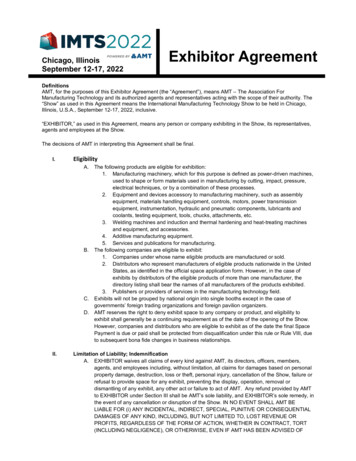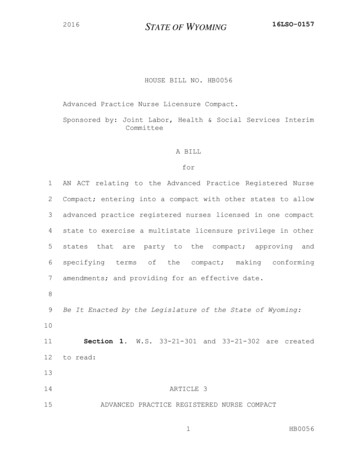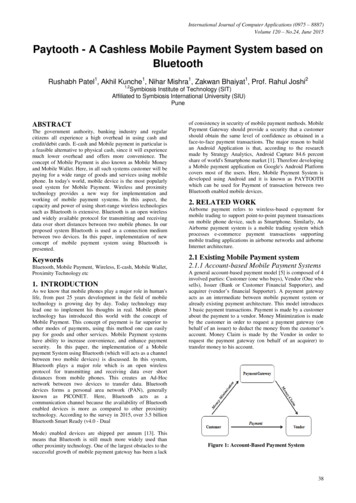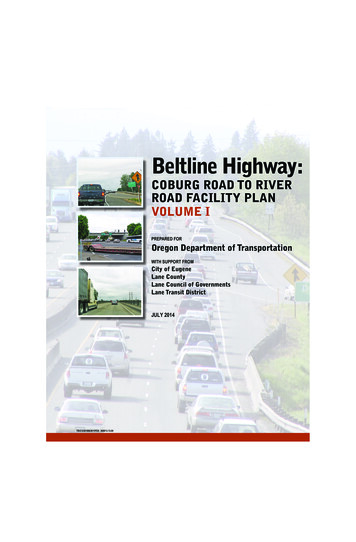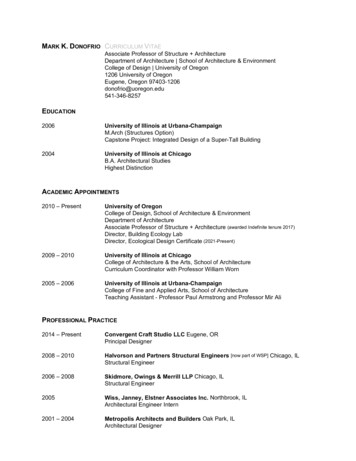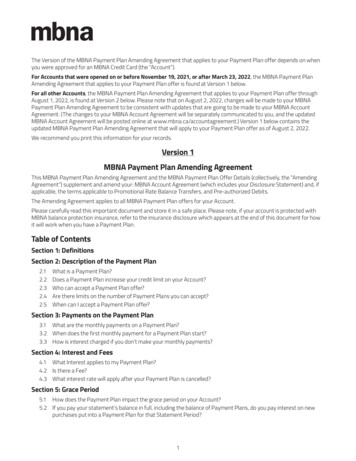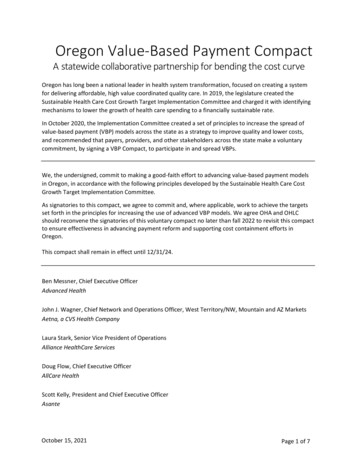
Transcription
Oregon Value-Based Payment CompactA statewide collaborative partnership for bending the cost curveOregon has long been a national leader in health system transformation, focused on creating a systemfor delivering affordable, high value coordinated quality care. In 2019, the legislature created theSustainable Health Care Cost Growth Target Implementation Committee and charged it with identifyingmechanisms to lower the growth of health care spending to a financially sustainable rate.In October 2020, the Implementation Committee created a set of principles to increase the spread ofvalue-based payment (VBP) models across the state as a strategy to improve quality and lower costs,and recommended that payers, providers, and other stakeholders across the state make a voluntarycommitment, by signing a VBP Compact, to participate in and spread VBPs.We, the undersigned, commit to making a good-faith effort to advancing value-based payment modelsin Oregon, in accordance with the following principles developed by the Sustainable Health Care CostGrowth Target Implementation Committee.As signatories to this compact, we agree to commit and, where applicable, work to achieve the targetsset forth in the principles for increasing the use of advanced VBP models. We agree OHA and OHLCshould reconvene the signatories of this voluntary compact no later than fall 2022 to revisit this compactto ensure effectiveness in advancing payment reform and supporting cost containment efforts inOregon.This compact shall remain in effect until 12/31/24.Ben Messner, Chief Executive OfficerAdvanced HealthJohn J. Wagner, Chief Network and Operations Officer, West Territory/NW, Mountain and AZ MarketsAetna, a CVS Health CompanyLaura Stark, Senior Vice President of OperationsAlliance HealthCare ServicesDoug Flow, Chief Executive OfficerAllCare HealthScott Kelly, President and Chief Executive OfficerAsanteOctober 15, 2021Page 1 of 7
Eric C. Hunter, President and Chief Executive OfficerCareOregonColumbia Pacific Coordinated Care OrganizationJackson Care ConnectTayo Akins, Chief Executive OfficerCascade Health AllianceRyan Kocher, Market President, Pacific NorthwestCignaSean Jessup, Chief Executive OfficerEastern Oregon Coordinated Care OrganizationChristopher Hummer, Chief Executive Officer and Plan PresidentHealth Net of OregonTrillium Community Health PlanJames Schroeder, Chief Executive OfficerHealth Share of OregonJeff Collins, Regional PresidentKaiser Permanente NorthwestKathryn Correia, President and Chief Executive OfficerLegacy Health SystemWilliam Johnson, PresidentModa HealthBetsy Boyd-Flynn, Executive DirectorOregon Academy of Family PhysiciansBecky Hultberg, President and Chief Executive OfficerOregon Association of Hospitals and Health SystemsAndrew R. Stolfi, Director and Insurance CommissionerOregon Department of Consumer and Business ServicesGeoff Brown, ChairOregon Educators Benefit BoardOctober 15, 2021Page 2 of 7
John G. Hunter, Chief Executive OfficerOHSU HealthPatrick M. Allen, DirectorOregon Health AuthorityBryan Boehringer, Chief Executive Officer and Executive Vice PresidentOregon Medical AssociationJoan Watson-Patko, Executive DirectorOregon Primary Care AssociationKenneth P. Provencher, President and Chief Executive OfficerPacificSourcePacificSource Health PlansPacificSource Community Health PlansPacificSource Community Solutions on behalf ofPacificSource Community Solutions – Central OregonPacificSource Community Solutions – Columbia River GorgePacificSource Community Solutions – LanePacificSource Community Solutions – Marion PolkAmy Mulcaster, ChairPortland Coordinated Care AssociationThe Portland ClinicNorthwest Primary CareCompass OncologyLisa Vance, Chief Executive, Oregon RegionProvidence Health and ServicesRobert Gluckman, Chief Medical OfficerProvidence Health PlanKimberly Hendricks, ChairPublic Employees’ Benefit BoardAngela Dowling, President and Chief Revenue OfficerRegence BlueCross BlueShield of OregonCheryl Nester Wolfe, President and Chief Executive OfficerSalem Health Hospitals and ClinicsOctober 15, 2021Page 3 of 7
Doug Boysen, Chair, Board of DirectorsSamaritan Health PlansSamaritan Health ServicesIntercommunity Health Network Coordinated Care OrganizationRichard L. Jamison, PresidentThe Oregon ClinicLori James-Nielsen, President and Chief Executive OfficerTuality HealthcareBrent Eichman, Chief Executive OfficerUmpqua HealthPatricia Auerbach, Chief Medical Officer, Pacific Northwest States, Montana, Alaska, HawaiiUnitedHealthcareSeamus McCarthy, President and Chief Executive OfficerYamhill Community CarePrinciplesFor the purposes of this document, “innovative payment models” are referred to as “advanced valuebased payment models” and are defined to include HCP-LAN Categories 3A and higher.1 Thisencompasses payment models with upside risk only, combined upside and downside risk, as well asprospective payment models. Prospective payment models include capitation, global budgets,prospective episode-based payment, and budget-based models with prospective payment andretrospective reconciliation.These principles build on value-based payment (VBP) efforts for Coordinated Care Organizations and thePrimary Care Payment Reform Collaborative.2 Their intent is to align efforts across public and privateinitiatives and markets to the extent possible, including the self-insured market, bringing an aggressivefocus on advanced value-based payment arrangements across the state.1. All members of the Sustainable Health Care Cost Growth Target Implementation Committee,plus representatives of other larger insurer, purchaser and provider organizations in the state,should develop a voluntary compact to increase the use of advanced value-based paymentmodels to Oregon’s providers that commit the signatories to these principles and to concreteaction steps to achieve these principles.1For an explanation of the Health Care Payment Learning and Action Network’s Alternative Payment Models (HCPLAN) framework, including a description of its defined payment models, see https://hcp-lan.org/apm-refresh- whitepaper/.2While these principles are conceptually and directionally aligned with the CCO 2.0 VBP Roadmap and withrecommendations from the Primary Care Payment Reform Collaborative, they do push Oregon payers and providersto adopt advanced VBP models more quickly. A CCO who signs the voluntary compact and works to meet the targetsoutlined in these principles will not be in conflict with their contractual requirements.October 15, 2021Page 4 of 7
2. The fee-for-service payment system has fundamental flaws and has not led to sustainable costsor promotion of improved quality, outcomes, or health equity in the health system.3. Providers, particularly those paid on a fee-for-service basis, face unique challenges due to theongoing COVID-19 pandemic. Increasing the use of advanced value-based payment models willhelp stabilize Oregon’s health system.4. Advanced value-based payment models are a critical strategy to contain costs to meet theestablished health care cost growth target. The appropriate advanced value-based paymentmodels may look different across the state, but implementation should be guided by theseprinciples.5. Prospective budget-based and quality-linked payment, where a provider is paid up front for apopulation of patients and a predefined set of services, should be the primary payment modelutilized wherever feasible for the following reasons:a. It provides critical financial stability to providers, particularly for small, independent,and rural providers, through a consistent source of revenue, which is an important partof alleviating the most damaging economic consequences of the pandemic.b. It is supportive of the Cost Growth Target because it defines a budget for the care of apopulation of patients.c. It gives providers the flexibility to address the most critical health needs of theirpatients, including non-medical social supports that might improve health and savecosts, rather than having to rely on reimbursable treatments.d. It allows for investment in a population of patients, and for flexibility in the type ofprovider delivering care and the type of care provided, which supports more holisticpatient-centered care.6. Prospective budget-based and quality-linked payments are not feasible today for all Oregonproviders due to lack of experience with advanced value-based payment and/or small providersize. Therefore, where they are not feasible to implement for a given line of business orprovider, advanced payments models that include both shared savings and downside risk shouldbe utilized, consistent with the intent of moving towards prospective payment models. Wherevalue-based payment models categorized as 3B and higher are not feasible, payers andproviders should implement value-based payment models categorized as 3A.7. Payers should have the following percentage of all their payments under advanced value-basedpayment models (3A and higher) in the following time periods:a.b.c.d.35% by 2021350% by 202260% by 202370% by 20243While contracts for 2021 may have been signed, nothing precludes a payer from offering to renegotiatecontracts to offer advanced value-based payment models.October 15, 2021Page 5 of 7
8. Payers should have the following percentage of their payments to primary care practices andgeneral acute care hospitals4 made under advanced value-based payment models, (3B andhigher) in the following time periods:a. 25% by 2022b. 50% by 2023c. 70% by 20249. Health plan enrollees should be encouraged or required to select a primary care provider,whether or not required by benefit design, to support advanced payment model effectiveness.10. Small and safety net providers should be offered technical assistance by payers and/or by OHA’sTransformation Center to set them up for success under advanced value-based payment models.Those with limited experience in value-based payment, such as behavioral health providers,should also be considered for technical assistance.11. The structure of advanced value-based payment models should be aligned across payers toallow providers to have a sufficient volume of similar value-based arrangements to makemeaningful change in their clinical practice and reduce administrative burden. Structuralalignment should include but not be limited to the use of common performance measures.12. Advanced value-based payment models should be designed with consideration of how to reduceexcess capacity in the system, while recognizing reasonable health system overhead required tomaintain flexible stand-by capacity. Implementation of value-based payment models should notbe used to reduce wages of low-income healthcare workers.13. Advanced value-based payment models should be designed and implemented withconsideration for unintended consequences, including potential adverse impacts on health carequality.14. Advanced value-based payments models should be designed to promote health equity, as wellas to mitigate adverse impacts on populations experiencing health inequities by:a. employing payment model design features and measures to protect against stinting,b. ensuring prospective payments are sufficient to cover the cost of infrastructure changesto support health equity (e.g. traditional health workers, changes to IT systems to trackequity),c. providing additional supports (e.g. technical assistance, infrastructure payments) forproviders serving populations experiencing health inequities,d. ensuring new upside or downside risks will not exacerbate existing inequities, ande. ensuring providers serving populations experiencing health inequities who are atgreater risk of closure due to COVID-19 remain open.Future efforts may also include adjusting payments based on social risk factors.4Non-federal, non-specialty hospitals open to the general public providing broad acute care.October 15, 2021Page 6 of 7
15. Implementation of advanced payment models should be accompanied by public transparency ofprice information, implemented through the Sustainable Health Care Cost Growth Target DataUse Strategy.16. These principles represent the shared vision of the Implementation Committee as of October2020. The passage of time and additional experience with advanced value-based paymentimplementation could inform future modifications to the targets herein. OHA should convenesigners of the voluntary compact no later than fall 2022 to revisit these principles and thecompact to ensure effectiveness in advancing payment reform and supporting reduced costgrowth in Oregon.ReferencesHCP LAN per/CCO 2.0 VBP s/Value-Based-Payment.aspxPrimary Care Payment Reform tive.aspxOctober 15, 2021Page 7 of 7
Eastern Oregon Coordinated Care Organization Christopher Hummer, Chief Executive Officer and Plan President Health Net of Oregon Trillium Community Health Plan James Schroeder, Chief Executive Officer Health Share of Oregon Jeff Collins, Regional President Kaiser Permanente Northwest Kathryn Correia, President and Chief Executive Officer Legacy Health System William Johnson, President Moda .


